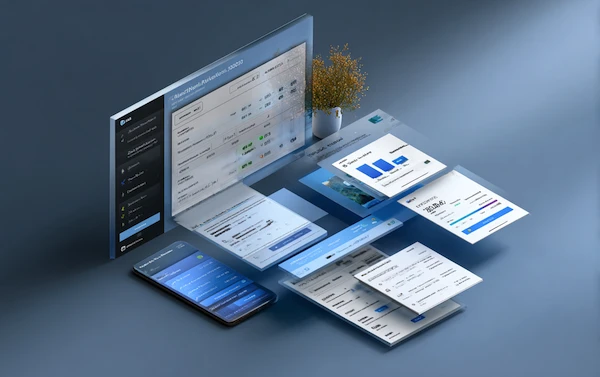What is a Rebate? How Does it Work in Business?

When looking to boost sales and promote customer loyalty, there are many strategies to try. Initiating a rebate program could be one. If you’ve ever wondered, “What is a rebate?” or “How do rebates work?” then you’re in the right place. We’re going to cover all the basics, as well as how to properly manage rebates so that you can achieve the results you desire.
Coming Up
What is a Rebate?
Let’s start with the rebate definition – a rebate is a partial return of funds back to a buyer once the purchase has been made. Rebates are often provided by service providers or manufacturers to boost sales and/or support improved customer loyalty and retention.
The biggest difference between rebates vs. discounts is that rebates happen after the sale has been made whereas discounts are lower prices offered at the point of sale. Since rebates occur after the sale has been made, they are a great way to continue customer engagement and interaction.
How Do Rebates Work?
Rebates can be looked at from the supplier side and the customer side to see how they work.
Let’s see each perspective:
- Customer Point of View: Sellers or manufacturers offer a rebate to customers. Customers have to save the receipt and submit a claim to receive the rebate. Once the seller verifies the claim and it meets the conditions of the rebate, the finances are processed and returned to the customer in the form of a check, credit for future purchases, or direct deposit.
- Supplier Point of View: In B2B relationships, suppliers must outline the contractual agreement to specify the rebate eligibility requirements. The supplier then has to track the purchases to make sure the conditions have been met. Once the target is achieved, suppliers must issue the rebate.
As you can tell, there is a lot of tracking and moving parts involved in rebate management. That’s why most businesses solicit the assistance of finance automation software with rebate management capabilities.
This way, you can easily design, track, and process rebates without having to sift through spreadsheets or perform manual calculations.
How Do Rebates Help Your Business?
Rebates help businesses in several ways, including:
- Driving customer loyalty and sales
- Protecting cash flow
- Understanding purchasing patterns
- Recognizing buyer behaviors
Rebate agreements make it possible to encourage consistent buying while maintaining price points. Additionally, by implementing rebates based on business cycles, businesses can stabilize their cash flow and plan their finances effectively.
Last but not least, by analyzing rebate data, businesses can get a sense of top-performing products and identify purchasing patterns.
Rather than having to crunch numbers and track purchases manually across spreadsheets, finance automation software with rebate management will do the heavy lifting for you. Finance automation software makes analysis easy so that business leaders have access to insights in real-time.
What are the Benefits of Rebates?
Rebates provide benefits to the business, as well as the buyer. Consider these advantages of implementing a rebate management program:
- Greater sales volume - with volume rebates, businesses can incentivize customers to buy in bulk, resulting in greater profits
- Customer savings - rebates save customers money, which can not only help improve loyalty, but may end up prompting a customer to buy more
- Brand reputation - rather than offering discounts continuously (which can affect a brand’s value perception), a rebate isn’t associated with price cuts at the point of sale, allowing for premium pricing conditions to be upheld
- Data and insights - Rebate management is the art of collecting data. With this data, companies can access insights that would otherwise be nonexistent, helping to highlight what products are highly sought after, as well as customers’ purchasing habits.
- Better partnerships - Rebates can lead to multi-year commitments and increased communication between business partners within supply chains
What are the Pros and Cons of Rebates?
The pros of rebates are listed above and are plentiful. Rather than considering the following as cons, they are challenges that businesses may face when initiating rebates (but they can all be overcome with adequate planning and technology).
Complexity
Rebates are complex inherently. Each one is tied to its own set of eligibility requirements, which then necessitates careful tracking and oversight. Plus, when customers reach out with inquiries, it means that a business has to be prepared to field the questions and respond in a timely manner.
Rebate management software will dramatically reduce the manual work that comes along with rebates, instead allowing team members to focus on initiatives and strategies to help boost sales, rather than tracking and calculations. It will also handle complex calculations, removing errors and reducing compliance risk.
Compliance
A business promise, especially one involving finance, is tied to regulations and compliance measures. Inadequacy to adhere to regulations can affect a business’ reputation, as well as its bottom line.
This is a big reason why rebate management software is so useful– it maintains that companies keep up with regulations and enforce rebate programs as promised.
What are the Types of Rebates?
When asking, “What is a rebate?” you’ll find that there are many different types of rebate programs you can design and enact. These include:
1. Volume Rebates
The goal of volume rebates is to get customers to purchase in bigger quantities. As customers reach higher thresholds buying, the percentage rebate tends to increase. The tiered setup of volume rebates provides a great incentive for customers to buy more at one time in order to get more money back incrementally as each purchasing threshold is passed.
2. Loyalty Rebates
Loyalty rebates are designed for a long-term relationship in which customers are incentivized to continue buying from the same supplier or provider over time. These tend to be set up as annual or multi-year programs that may include greater benefits for each successive year of participation.
3. Growth Rebates
Growth rebates establish a benchmark by customer and then reward increased purchasing behavior over time. As a result, companies can encourage year-over-year growth with their customers and develop a long-standing, successful partnership. Together, incentives are aligned for the seller and buyer for mutual revenue growth.
4. Product Mix Rebates
Many businesses realize that they have certain goods that sell through well, and others that are challenging to get off the shelves. In these cases, a product mix rebate can prove to be very beneficial as it combines product categories or combinations to mix popular items with less popular items. By doing so, businesses can promote customer adoption across product ranges and differentiate itself from the competition.
5. Promotional Rebates
Promotion rebates tend to occur for a short period of time and are often associated with the introduction of new products. With a limited timeframe designated during product launches, promotional rebates allow businesses to focus on specific products and/or clear out excess or seasonal inventory.
How to Calculate Rebates?
Rebates can be calculated using two different formulas, the percent rebate calculation or the flat amount rebate.
Here’s a look at the equations:
Percent Rebate:
Rebate percentage = (original purchase amount / total rebate amount) x 100
Flat Amount Rebate:
Rebate = Number of units x rebate per unit
These are straightforward examples of rebate calculations, but as your rebate program becomes more complex or stratified, keeping up with calculations gets harder.
This is especially true as transaction volume grows and you have sales across different locations. Instead of having to think about calculations by hand, you can rely on finance automation software to keep track of sales and perform rebate calculations.
How to Automate Complex Rebate Calculations?
Automating complex rebate calculations is as easy as implementing finance automation software with rebate management to do it for you.
If you’re wondering how it works, this is what you can expect the software to do for you:
- Connect data from different systems
- Track purchases across currencies and locations in real-time
- Automatically apply rebate program rules
- Create audit-ready reports
- Process rebate payment for approval
What are Rebates vs Discounts?
We touched on it briefly before, but the difference between rebates and discounts is important to know so you can decide what makes more sense to use for your business at any given point in time.
For the most part, companies don’t want to continuously offer discounts as it can tarnish the perception of the brand. Rebates offer a way to reap the same results as discounts, without affecting brand reputation. However, they entail more planning, maintenance, and effort, which is why so many companies leverage rebate management software.
What Factors to Consider When Offering a Rebate?
While rebates deliver advantages to both the supplier and customer alike, they are often perceived to be better for the supplier because there’s friction involved for customers. Customers have to follow through the steps to get their money back, whereas businesses will still benefit from the sale that was made.
To ensure that customers get the most from your rebate program, consider these best practices:
- Make the submission process simple (provide a mail-in and digital option)
- Clarify submission deadlines and align them with cash flow needs
- Use rebates during seasonally low or slow periods to boost sales
- Test out different rebate types and amounts to see what works
- Ensure your staff knows how to manage rebates
- Implement technology that can help make rebate management stress-free!
Closing Thoughts
Now that you can answer, “What is a rebate?” it’s the perfect opportunity to design your own!
Rather than having to add another task to your finance, sales, and marketing team’s list of things to do, you can deploy finance automation software that will automate and streamline the rebate management needs for your teams, saving you time, money and improving your profits.
FAQ
Intelligent reconciliation solution
Intelligent rebate management solution
Intelligent financial automation solution
Intelligent Financial Automation Solution
Intelligent financial automation solution
Intelligent financial automation solution
Intelligent financial automation solution
Intelligent financial automation solution
Intelligent regulatory reporting solution
Free up time and reduce errors
Recommended for you

Request a Demo
Book a 30-minute call to see how our intelligent software can give you more insights and control over your data and reporting.

Reconciliation Data Sheet
Download our data sheet to learn how to automate your reconciliations for increased accuracy, speed and control.

Regulatory Reporting Data Sheet
Download our data sheet to learn how you can prepare, validate and submit regulatory returns 10x faster with automation.

Financial Automation Data Sheet
Download our data sheet to learn how you can run your processes up to 100x faster and with 98% fewer errors.

Financial Automation Data Sheet
Download our data sheet to learn how you can run your processes up to 100x faster and with 98% fewer errors.

Financial Automation Data Sheet
Download our data sheet to learn how you can run your processes up to 100x faster and with 98% fewer errors.

Financial Automation Data Sheet
Download our data sheet to learn how you can run your processes up to 100x faster and with 98% fewer errors.

Financial Automation Data Sheet
Download our data sheet to learn how you can run your processes up to 100x faster and with 98% fewer errors.

Financial Automation Data Sheet
Download our data sheet to learn how you can run your processes up to 100x faster and with 98% fewer errors.

Rebate Management Data Sheet
Download our data sheet to learn how you can manage complex vendor and customer rebates and commission reporting at scale.

Top 10 Automation Challenges for CFOs
Learn how you can avoid and overcome the biggest challenges facing CFOs who want to automate.
.svg)




